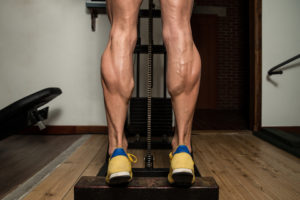Calf Muscle Strain/Tear

Two muscles compose the “calf” of the lower leg: the gastrocnemius and soleus. The former has two heads which attach above the knee on the back of the femur (thigh bone). The latter attaches on the back of the shin bone (tibia). Together these muscles form into the Achilles tendon – the largest tendon in the human body – which attaches to the back of the heel bone (calcaneus). The primary function of these muscles is to bend the ankle downward, or what is called plantarflexion. This movement occurs thousands of times every day and even more so during running. A tremendous force is exerted through the muscles and tendon in order for the body to function properly.
What is a calf strain?
A strain is an injury in which muscle fibers are stretched or torn. People commonly refer to such injuries as a “pulled muscle.” A calf strain occurs when too much force is generated in the muscle and the tissue stretches too far or tears. This excess force can be generated when an athlete pushes down forcefully with their foot or when the ground pushes back forcefully against the foot. Sometimes it’s a combination of these two forces. In some instances, the injury is accompanied by a sharp, burning sensation or a “pop” sensation in the back of the calf. It’s important to distinguish a calf muscle strain from an Achilles strain or tear. The latter occurs lower and behind the ankle or back of the heel.
How is a calf strain/tear diagnosed?
A doctor or therapist can often determine if a muscle is strained or torn by the location of pain and the strength of the muscle. Certain clinical tests can differentiate a simple strain from a partial or complete tear. An ultrasound or MRI can be used to confirm the diagnosis or aid in treatment.
How is a calf strain/tear treated?
Treatment of a calf muscle strain or tear generally involves reducing the immediate inflammation. This may take 5-7 days. Ice and anti-inflammtory medication are the mainstays of initial treatment. Rest also helps reduce pain and prevent further damage. Depending on the severity of the injury, immobilization in a cast boot or with crutches may be necessary. Ace bandages and compression sleeves are often helpful in controlling swelling in the damaged muscle tissue. Once the immediate inflammation and pain begin to subside, physical therapy and home therapy become important. Changes in activity may be required for several weeks or in some instances several months while the tissue heals.
When can a runner return to activity after a calf strain/tear?
The goal of rehabilitation is to return an athlete to their preferred sport as soon as safely possible. Returning too early will delay healing and lead the potential for further damage to the muscle tissue. Essentially, this starts the clock all over again. Everyone recovers at a different rate and each injury can be unique. A return to running is determined by clinical factors such as regaining proper strength and flexibility, being able to perform everyday activities without pain, and the ability of an athlete to run without pain. Overall, healing may take a few weeks in some cases or several months in more severe injuries.
Can calf strains/tears be prevented?
The best method to reduce calf strains is by maintaining proper strength and flexibility in the muscle. In some studies, as much as 88% of athletes with foot and ankle pain, of any sort, have tight calf muscles. Consequently, calf stretches are a mainstay in reducing the possibility of a calf injury.
This information is not intended to diagnose, treat, or prevent any injury or disease. It is intended to serve as an overview of running-related injuries and should not be used as a substitute for sound medical advice from a doctor or therapist.


